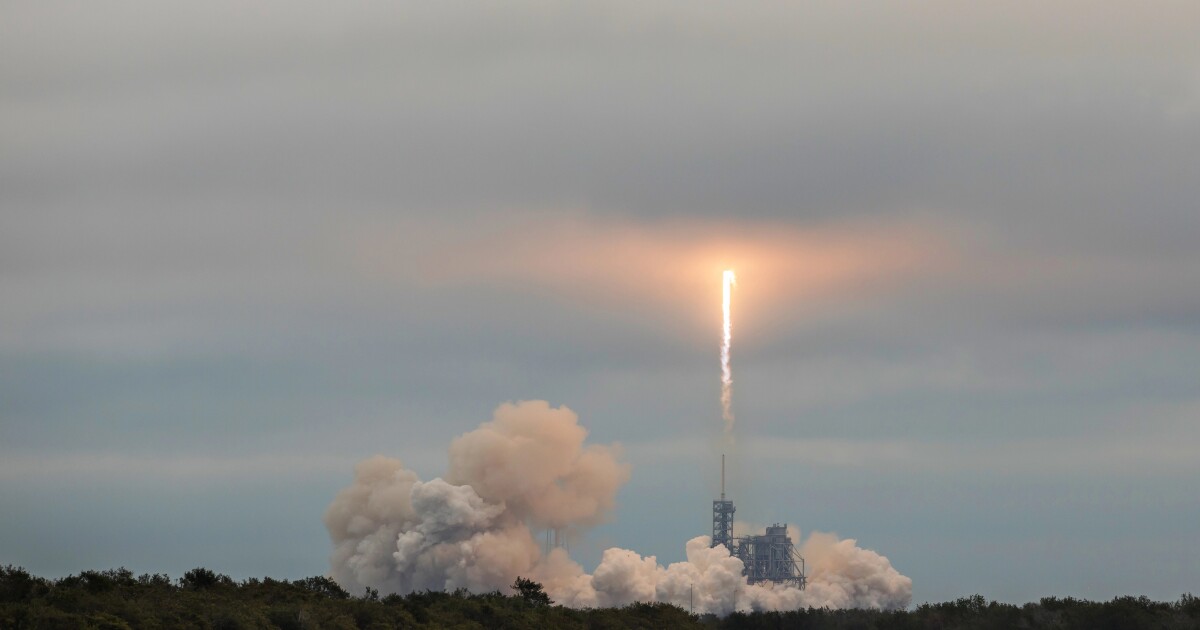Rocket launches are blasting a new hole in our ozone layer – New Atlas

Report on the Impact of Rocket Emissions on the Ozone Layer and Sustainable Development Goals
1.0 Introduction: A New Threat to Global Environmental Progress
The rapid expansion of the commercial spaceflight industry presents a significant challenge to global environmental stability and the achievement of the United Nations Sustainable Development Goals (SDGs). While representing a milestone in human innovation, increased rocket launch frequency is introducing harmful chemical residues into the stratosphere, threatening to reverse decades of progress in ozone layer recovery established under the Montreal Protocol. This report analyzes the environmental impact of rocket emissions, with a specific focus on its implications for SDG 3 (Good Health and Well-being), SDG 13 (Climate Action), SDG 14 (Life Below Water), SDG 15 (Life on Land), and the need for action under SDG 9 (Industry, Innovation, and Infrastructure), SDG 12 (Responsible Consumption and Production), and SDG 17 (Partnerships for the Goals).
2.0 Analysis of Impact on Sustainable Development Goals (SDGs)
2.1 SDG 13 (Climate Action): Direct Impacts on Atmospheric Integrity
Rocket launches directly undermine SDG 13 by degrading the ozone layer, a critical component of the Earth’s climate system. Exhaust products, including soot and metallic particles, not only trigger ozone-depleting chemical reactions but also trap heat in the upper atmosphere. This dual impact compromises the atmospheric shield that regulates the planet’s climate and protects life from harmful radiation.
2.2 SDG 3 (Good Health), SDG 14 (Life Below Water), and SDG 15 (Life on Land)
The integrity of the ozone layer is fundamental to achieving health and biodiversity goals. Ozone depletion allows increased levels of harmful ultraviolet (UV) radiation to reach the Earth’s surface, posing direct threats to:
- Human Health (SDG 3): Increased risk of skin cancers, cataracts, and other health conditions.
- Ecosystems (SDG 14 & 15): Damage to terrestrial and aquatic ecosystems, including vital marine phytoplankton, which form the base of the oceanic food web.
3.0 Scientific Assessment of Rocket Emissions
3.1 Primary Ozone-Depleting Substances
The primary agents of ozone destruction from rocket launches include:
- Gaseous Chlorine: Released from solid rocket propellants, it catalytically destroys ozone molecules with high efficiency.
- Black-Carbon Soot: Emitted from fuel burns, it absorbs heat, warming the stratosphere and accelerating ozone-depleting reactions.
- Nitrogen Oxides and Metallic Dust: Released during the re-entry and burn-up of satellites and rocket components, these substances contribute directly to ozone depletion and can amplify destructive chemical processes.
3.2 Projections from Modeling Studies
Recent atmospheric modeling provides quantitative forecasts of potential ozone damage based on industry growth:
- Current State: The ozone layer remains approximately 2% thinner than pre-depletion levels, indicating that recovery is incomplete and vulnerable.
- Moderate Growth Scenario (approx. 884 launches/year): Projected to cause a 0.17% thinning of the global ozone layer by 2030.
- High Growth Scenario (approx. 2,040 launches/year): Projected to cause a 0.29% global ozone loss, with a more severe depletion of nearly 4% over Antarctica.
These figures indicate that unchecked growth in the launch industry could significantly offset the healing achieved under the Montreal Protocol.
4.0 Aligning Space Industry Innovation with Sustainability
4.1 The Imperative for SDG 9 and SDG 12
The current trajectory of the space launch industry is inconsistent with the principles of sustainable industrialization and responsible production.
- SDG 9 (Industry, Innovation, and Infrastructure): The challenge is to steer innovation towards sustainable infrastructure. This requires a transition away from polluting propellants towards cleaner technologies, such as cryogenic liquid fuels (liquid oxygen and hydrogen), which have negligible ozone impact but are currently used in only 6% of launches.
- SDG 12 (Responsible Consumption and Production): The industry must adopt sustainable production patterns by phasing out chlorine- and soot-heavy solid fuels in favor of environmentally benign alternatives.
5.0 Recommendations and Path Forward
5.1 A Call for Global Partnership under SDG 17
Addressing the threat of rocket emissions requires a coordinated global response modeled on the success of the Montreal Protocol, directly invoking SDG 17 (Partnerships for the Goals). Collaboration between scientists, regulatory bodies, and the commercial space industry is essential for developing and implementing a sustainable framework for space exploration.
5.2 Key Recommendations
To mitigate the environmental impact of the growing space industry and ensure its alignment with the SDGs, the following actions are essential:
- Implement Comprehensive Emissions Tracking: Establish a global standard for monitoring and reporting emissions from both launch and re-entry phases.
- Phase Out Harmful Propellants: Create a regulatory framework, similar to the Montreal Protocol, to phase out the use of chlorine-based solid propellants and soot-heavy fuels.
- Incentivize Cleaner Propulsion Technologies: Promote research, development, and adoption of cleaner fuel systems, such as cryogenic and other low-impact alternatives.
- Integrate Environmental Oversight: Embed stringent environmental impact assessments and sustainability criteria into the launch authorization and regulatory pipeline for all space activities.
Analysis of Sustainable Development Goals in the Article
1. Which SDGs are addressed or connected to the issues highlighted in the article?
- SDG 3: Good Health and Well-being – The article discusses the ozone layer’s role in shielding life from harmful ultraviolet radiation, a direct factor in human health.
- SDG 9: Industry, Innovation, and Infrastructure – The focus is on the space launch industry, its rapid growth, and the need for technological innovation toward cleaner propulsion systems.
- SDG 12: Responsible Consumption and Production – The article addresses the environmental impact of production and consumption patterns within the space industry, specifically concerning rocket propellants and their emissions.
- SDG 13: Climate Action – Protecting the ozone layer is a critical component of atmospheric science and global climate action. The article directly links rocket emissions to atmospheric changes.
- SDG 15: Life on Land – The ozone layer is essential for protecting all terrestrial ecosystems and biodiversity from harmful UV radiation. Its depletion threatens life on land.
- SDG 17: Partnerships for the Goals – The article highlights the success of the Montreal Protocol, a global partnership, and calls for similar “careful coordination of scientists and regulators” to address the new threat.
2. What specific targets under those SDGs can be identified based on the article’s content?
-
SDG 3: Good Health and Well-being
- Target 3.9: By 2030, substantially reduce the number of deaths and illnesses from hazardous chemicals and air, water, and soil pollution and contamination. The article explains that a thinning ozone layer lets “harmful ultraviolet radiation pour through,” which is a direct cause of illness.
-
SDG 9: Industry, Innovation, and Infrastructure
- Target 9.4: By 2030, upgrade infrastructure and retrofit industries to make them sustainable, with all countries taking action in accordance with their respective capabilities. The article’s conclusion calls for “advancing cleaner propulsion” and “phasing out chlorine- and soot-heavy fuels,” which directly relates to retrofitting the space launch industry for sustainability.
-
SDG 12: Responsible Consumption and Production
- Target 12.4: By 2020, achieve the environmentally sound management of chemicals and all wastes throughout their life cycle… and significantly reduce their release to air, water and soil to minimize their adverse impacts on human health and the environment. The article details the release of harmful residues like “gaseous chlorine and soot,” “nitrogen oxides and metallic dust” into the atmosphere, highlighting the need for their sound management.
-
SDG 13: Climate Action
- Target 13.2: Integrate climate change measures into national policies, strategies and planning. The article warns that the expanding launch industry could “offset much of the healing achieved under the Montreal Protocol,” implying the need for new policies and regulations to manage this atmospheric threat.
-
SDG 15: Life on Land
- Target 15.5: Take urgent and significant action to reduce the degradation of natural habitats. The ozone layer is a critical component of the global habitat that “shields life below.” The article describes how rocket emissions “unravel ozone,” contributing to the degradation of this protective natural shield.
-
SDG 17: Partnerships for the Goals
- Target 17.14: Enhance policy coherence for sustainable development. The article cites the Montreal Protocol as a successful example of global policy coherence and calls for new “careful coordination of scientists and regulators” and “oversight into the launch pipeline” to manage the impacts of the modern space industry.
3. Are there any indicators mentioned or implied in the article that can be used to measure progress towards the identified targets?
- Rate of ozone depletion/thinning: The article provides specific quantitative data, such as the ozone layer being “about 2% thinner than before,” and models projecting thinning of “0.17% by 2030” or “nearly 4% over Antarctica” under different scenarios. This directly measures the impact on the atmosphere.
- Volume of rocket launches: The article states that “Annual launches have more than doubled since 2019” and uses figures like “884 launches per year” and “2,040 annual launches” in its models. Tracking this number serves as an indicator of the scale of industrial activity causing the pollution.
- Emissions of specific pollutants: The article identifies “gaseous chlorine and soot” as the “strongest contributors to ozone loss.” It also mentions “nitrogen oxides and metallic dust” from re-entry. Measuring the atmospheric concentration of these specific substances would be a direct indicator of pollution levels.
- Adoption of cleaner technologies: The article implies an indicator by stating that cleaner propellants like “cryogenic liquids such as oxygen and hydrogen” are “used in only about 6% of launches today.” An increase in this percentage would indicate progress towards sustainable industry practices (Target 9.4).
- Reduction in ozone-depleting substances: The article references the historical success of the Montreal Protocol, where “CFC emissions fell by 99%.” This serves as a model indicator for measuring the success of future regulations on rocket emissions.
4. Create a table with three columns titled ‘SDGs, Targets and Indicators” to present the findings from analyzing the article.
| SDGs | Targets | Indicators |
|---|---|---|
| SDG 3: Good Health and Well-being | 3.9: Reduce deaths and illnesses from hazardous chemicals and air pollution. | Percentage of ozone layer thinning (e.g., “2% thinner,” “0.17% by 2030”). |
| SDG 9: Industry, Innovation, and Infrastructure | 9.4: Upgrade infrastructure and retrofit industries to make them sustainable. | Percentage of launches using cleaner propulsion (e.g., cryogenic liquids currently at “6% of launches”). |
| SDG 12: Responsible Consumption and Production | 12.4: Achieve environmentally sound management of chemicals and wastes. | Atmospheric concentration of rocket-related pollutants (e.g., “gaseous chlorine and soot,” “nitrogen oxides”). |
| SDG 13: Climate Action | 13.2: Integrate climate change measures into national policies and planning. | Number of annual rocket launches (e.g., “doubled since 2019,” scenarios of “884” to “2,040” launches per year). |
| SDG 15: Life on Land | 15.5: Reduce the degradation of natural habitats. | Size of the Antarctic ozone hole and global ozone layer thickness measurements. |
| SDG 17: Partnerships for the Goals | 17.14: Enhance policy coherence for sustainable development. | Establishment of coordinated regulatory frameworks and oversight for the launch industry, modeled on the Montreal Protocol. |
Source: newatlas.com
What is Your Reaction?
 Like
0
Like
0
 Dislike
0
Dislike
0
 Love
0
Love
0
 Funny
0
Funny
0
 Angry
0
Angry
0
 Sad
0
Sad
0
 Wow
0
Wow
0



















































.jpg.webp?itok=0ZsAnae9#)






/environment-climate-change-and-health-(ech)/water-sanitation-hygiene-and-health-(wsh)/landfill-tuvalu-36092.tmb-1200v.jpg?sfvrsn=5c21fe40_1#)

















